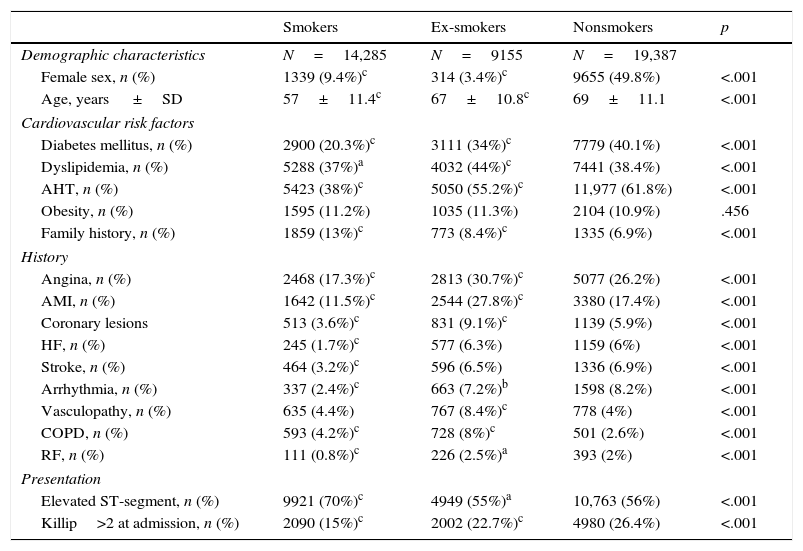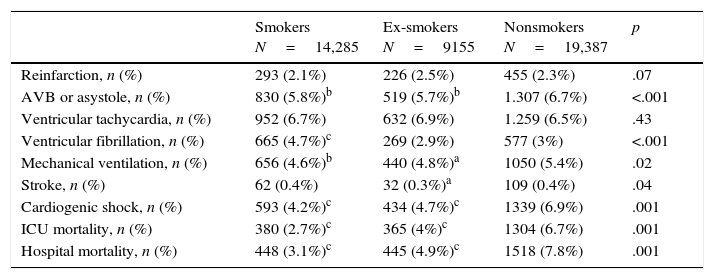The tobacco paradox is a phenomenon insufficiently explained by previous studies. This study analyses the prognostic role of prior or active smoking in patients with acute coronary syndrome.
MethodsWe obtained data from the ARIAM registry, between 2001 and 2012. The study included 42,827 patients with acute coronary syndrome (mean age, 65±13 years; 26.4% women). The influence of smoking and that of being an ex-smoker on mortality was analysed using a multivariate analysis.
ResultsThe smokers were younger, were more often men, had less diabetes, hypertension and prior history of heart failure, stroke, arrhythmia and renal failure and more frequently had ST-elevation and a family history of smoking. The ex-smokers had more dyslipidaemia and history of angina, myocardial infarction, ischemic heart disease, peripheral vasculopathy and chronic bronchial disease. Smokers and ex-smokers less frequently developed cardiogenic shock (smokers 4.2%, ex-smokers 4.7% and nonsmokers 6.9%, p<.001). Hospital mortality was 7.8% for the nonsmokers, 4.9% for the ex-smokers and 3.1% for the smokers (p<.001). In the multivariate analysis, the smoker factor lost its influence in the prognosis (–0.26%, p=.52 using an inverse probability calculation; and +0.26%, p=.691 using a propensity analysis). However, the exsmoker factor showed a significant reduction in mortality in both tests (–2.4% in the inverse probability analysis, p<.001; and –1.5% in the propensity analysis, p=.005).
ConclusionsThe tobacco paradox is a finding that could be explained by other prognostic factors. Smoking cessation prior to hospitalization for acute coronary syndrome is associated with a better prognosis.
La paradoja del tabaco es un fenómeno insuficientemente explicado en estudios previos. Este estudio analiza el papel pronóstico del tabaquismo previo o activo en pacientes con síndrome coronario agudo.
MétodosObtuvimos los datos del registro ARIAM, entre 2001 y 2012. Se incluyó a 42.827 pacientes con síndrome coronario agudo (edad media 65±13 años, 26,4% mujeres). Se analizó la influencia del hábito tabáquico o de la condición de exfumador en la mortalidad mediante análisis multivariados.
ResultadosLos fumadores eran más jóvenes, más frecuentemente hombres, tenían menos diabetes, hipertensión e historia previa de insuficiencia cardiaca, ictus, arritmia e insuficiencia renal, así como más frecuentemente elevación del ST e historia familiar. Los exfumadores presentaban más dislipidemia e historia de angina, infarto de miocardio, cardiopatía isquémica, vasculopatía periférica y broncopatía crónica. Fumadores y exfumadores desarrollaron menos frecuentemente shock cardiogénico (fumadores 4,2%, exfumadores 4,7% y no fumadores 6,9%, p<0,001). La mortalidad hospitalaria fue del 7,8% en los no fumadores, un 4,9% en los exfumadores y un 3,1% en los fumadores (p<0,001). En el análisis multivariado, el carácter fumador perdió su influencia en el pronóstico (–0,26%, p=0,52 mediante cálculo de probabilidad inversa; y +0,26%, p=0,691 mediante análisis de propensión). Sin embargo, el carácter exfumador mostró una reducción significativa de la mortalidad en ambos test (–2,4% en el análisis de probabilidad inversa, p<0,001, y –1,5% en el análisis de propensión, p=0,005).
ConclusionesLa paradoja del tabaco es un hallazgo que puede explicarse por otros factores pronósticos. El abandono del hábito tabáquico previo a un ingreso por síndrome coronario agudo se asocia a un mejor pronóstico.
Article
Diríjase desde aquí a la web de la >>>FESEMI<<< e inicie sesión mediante el formulario que se encuentra en la barra superior, pulsando sobre el candado.

Una vez autentificado, en la misma web de FESEMI, en el menú superior, elija la opción deseada.

>>>FESEMI<<<









